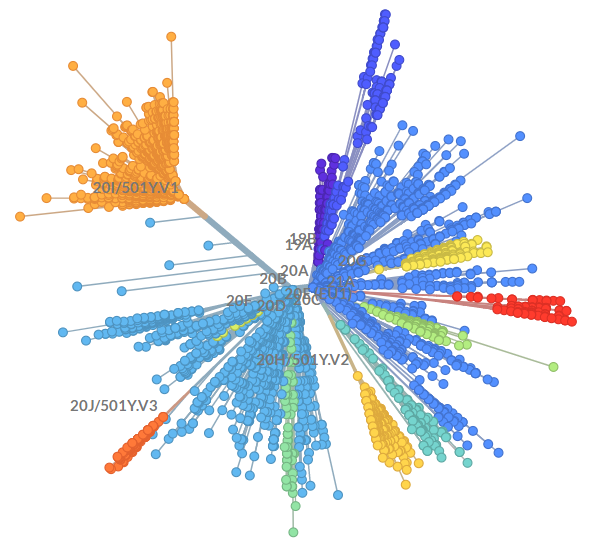Clades of COVID-19
Evolution of the COVID-19 virus showed an explosion of molecular diversity, resulting in the need for boosters that differed from the original vaccine. The COVID variants, illustrated below reveal significant evolution of the virus during the first year of the pandemic. The groups of viral strains or clades are grouped by color, while distance of separation indicates molecular divergence, or the number of distinct mutations. As they accumulate the mutations render the original vaccine less effective. COVID also saw dramatic reduction in older vaccine efficacy against new variants.

The second graphic below provide an alternative representation of the clades, showing the time of onset of the various waves of dominant variants of COVID that swept the globe in 2020 and early 2021. Several things are notable from the colored part of the figure. First, there are continuous changes of the dominant type of virus resulting from evolutionary competition for infection and replication. Because the viral infection-replication cycle can be as short as a few days, the limited genetic space of the virus (~28,000 basepairs) is intensely sampled by the evolution, resulting in an informatics search by carried out by biology itself that we call bio-computation. What is notable from the upper half of the figure is that mutations are preferentially occurring at specific positions of the genome characterized by tall spikes measuring “Diversity”. This reflect a consensus of genomic “hot spots” and is a form of “convergent evolution”, where the same practical solutions (that control infectivity and transmissibility of the virus similar to the evolution of sight and flight) are invented by nature independently.

Clonal evolution in cancer
The evolution of COVID-19 provides a window into development of cancer. Cancer is essentially abnormally selfish cell behavior when cells that lose inhibition for proliferation, growth, and cell division that has a detrimental effect on a complex system, like a body. Cancer results when multiple gatekeeping oncogenes are effectively incapacitated or subverted by mutations. Some specific examples of oncogenes driving different cancers are shown at the bottom of this post.
Cancer is often described by medical professionals as neoplasm, or new growth of tissue. The extent of cancerous character depends on which oncogenes that are mutated, as well as the accumulation of a number of such “hits”. During its growth cancer needs to overcome multiple problems, including but not limited to intrinsic and extrinsic signals that would reduce its growth (or cause programmed cell death), restraining factors in the extracellular matrix surrounding the cells, undersupply of blood to a growing cancerous mass, and attacks by the immune system. Typically, 5-6 hits need to accumulate in order for cancer cells to reach a dangerous phase, beyond benign neoplasm. There’s a natural progression of cancer aggressiveness and invasiveness, called metastasis.
As the image below shows, there are subgroups or clones that arise in the cancer cell population leading to increasing proliferation of more selfish and cancerous lineages. This analysis is very important in treating cancer, because too often standard lines of therapy effectively eliminate the major clone but leave behind some minor clones, which may be detected as Minimal Residual Disease (MRD). The relatively few surviving cancer cells are resistant to the therapy and if left untreated, eventually additional mutations to arise, leading to a more aggressive cancer and relapse.

Implications for evolving targets: COVID and cancer
The commonality of evolution of COVID clades and cancer clonal lineages has implications for tracking these diseases as well as treating them. As experience showed, COVID-19 adopted to humans, become less lethal and now the CDC views it as another form of common cold, not unlike NL63, OC43, HKU1 and 229E coronaviruses. There coronaviruses have been long known to infect humans and have no vaccines.
Both viruses and cancer are evolving living systems, which in aggregate perform a massive biological search of possible mutations and biological possibilities. Medical practice is starting to utilize single-cellular level analysis for personalized therapy, although these technologies are expensive and not universally practiced. Majority of cancer therapies still do not measure clonal diversity before or after treatment, which is critical to understand effectiveness of the therapy and likelihood of a relapse.
Examples of Oncogenes driving specific cancers
The following table is reproduced from Recent Advances in Metabolites from Medicinal Plants in Cancer Prevention and Treatment | Bentham Science (eurekaselect.com)


